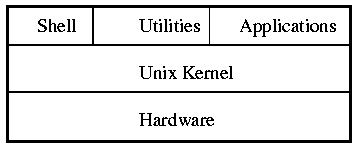| Introduction to Data Communications | ||
|---|---|---|
|
|
51. Quick Introduction to UNIX | Next |
The purpose of this section is as a basic introduction to Unix and the reader should be aware that there are many in-depth books written on Unix that are available on-line and off-line.
History
The name Unix is not an acronym but a pun on an early operating system called Multics. Unix was original thought of as an emasculated version of Multics (called Unics).
Unix was developed in the early 70s by Bell Telephone Laboratories. Unix was developed using the C language and is easily ported to other platforms. Unix is nonpropriertary - it is not tied to a specific software vendor or tied to a specific hardware platform.
Design of the Unix System
The Unix system consists of the kernel system layer atop the hardware.

The essential core of the Unix operating system is called the kernel. This is the software layer that interacts most closely with the computer hardware. The command interpreter which implements the users commands is called the shell - this is similar to DOS's command line. The shell can also be a GUI (Graphical User Interface) like X Windows.
Also on top of the kernel would run user applications and utilities. Utilities are print managing programs, format commands, etc...
One of the main reasons that Unix has become so popular is the layered approach that the Unix operating system has taken. This has made it very easy to port to other hardware systems.
Unix Variants
Because Unix is nonpropriertary, and has been modified by thousands of programmers at Bell Systems, universities and research organizations around the world, there are may variants of Unix.
The most popular flavours of Unix are (in no particular order):
These Unix variants are descendants of the original AT&T Unix code.
Other operating systems are Unix-like in that they have been written from scratch to emulate the behaviour of some versions of Unix. Examples are: Coherent and QNX.
Personal Unix Systems
Unix can be run on IBM PCs, the most common implementation is LINUX. Linux is available off the Internet for free from various distributions. All distributions have the same basic kernel called Linux. The distributions package the Linux kernel with the programs that they feel will provide the best overall package. The programs that they add are custom installation programs, office packages, programming suites, server software, networking software, games, etc..
The most common distributions are (in no particular order):
| Introduction to Data Communications | ||
|---|---|---|
|
|
Table of Contents | Next |